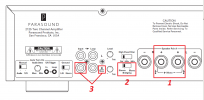I got an expedited delivery of a A07MAX and I have been listening and comparing it with my Fosi Audio V3.
And, I thought I would share my initial opinions:
So for me so far the advantanges of the MAX compared to the Fosi Audio V3:
1. New Design and the Board layout
I think the wider design on the MAX allows allot more space at the back of the Ampflifier - meaning cables are well separated - see photo below. They effectively redesigned the MAX so it's wide instead of deep.
2. Nicer binding Posts
The “offset” of the binding posts is much better and I think they have much higher quality binding posts than the V3,
3. Mono mode (and the switch)
This is a great option IMO - it shows off the upgradability - i.e. start with 1 A07MAX in stereo, then buy a second one and setup each as a Mono Block Amplifier (with a pre-amp controlling the volume)
The advantages of the V3 compared to the MAX:
1. Volume control has a “logarithm” taper Pot - so it has more subtle control over lower volumes
The MAX volume is nicer than previous Aiyima Amps but linear on the V3 really nice and it is very subtle with lower volumes
2. Lower THD+N / Higher SINAD value
The Aiyima published SINAD results for A07 MAX are slightly behind the V3 as far as SINAD / THD+N. Note: I did ask them to send a MAX to Amir for some official measurements so we can get AP definitive results - but I imagine Aiyima published results are accurate as they are in line with previous measurements.
3. Some may like the vent hole pattern on the top of the V3 - obviously both have the vent holes on the bottom and on the sides but the V3 vents on the top have a nice pattern ( though I do wonder about stacking components with the V3).
Note: I personally think both companies should look are providing pre-amps with their new 'house' designs (maybe ultimately DACs) as I would buy a pre-amp especially to control the volume of either as mono-blocks but especially if the pre-amp had a similar design.
I did some basic REW FR and distortion measurements matching the V3 with the MAX and mostly its no surprise they were exactly the same (this is using the same equipment and volume matching) - I did use the 36V that came with the MAX on both then I swapped the power supply to a 48V one I got with my V3 and used for both for some extra measurements) :
This was using the same 36V and volume matched they have identical FR (in my room - excuse the lack of Room correction and EQ as I kept the "stack" to a basic source, the amplifiers and speakers. Obviously they sounded the same to me.
Then I swapped the power supply (and thought it might be interesting to look at distortion - though again its almost identical):
A07-MAX - distortion:
Fosi Audio V3 distortion:
]]
I haven't take the MAX apart yet - though I did briefly open it up to see what might be accessible without removing the volume:
I plan to do more comparisons over the next few days and I will report back.
So in summary, so far I think it's a very nice upgrade over the A07 and IMO having this competition between manufacturers is a great way to move the industry forward.


